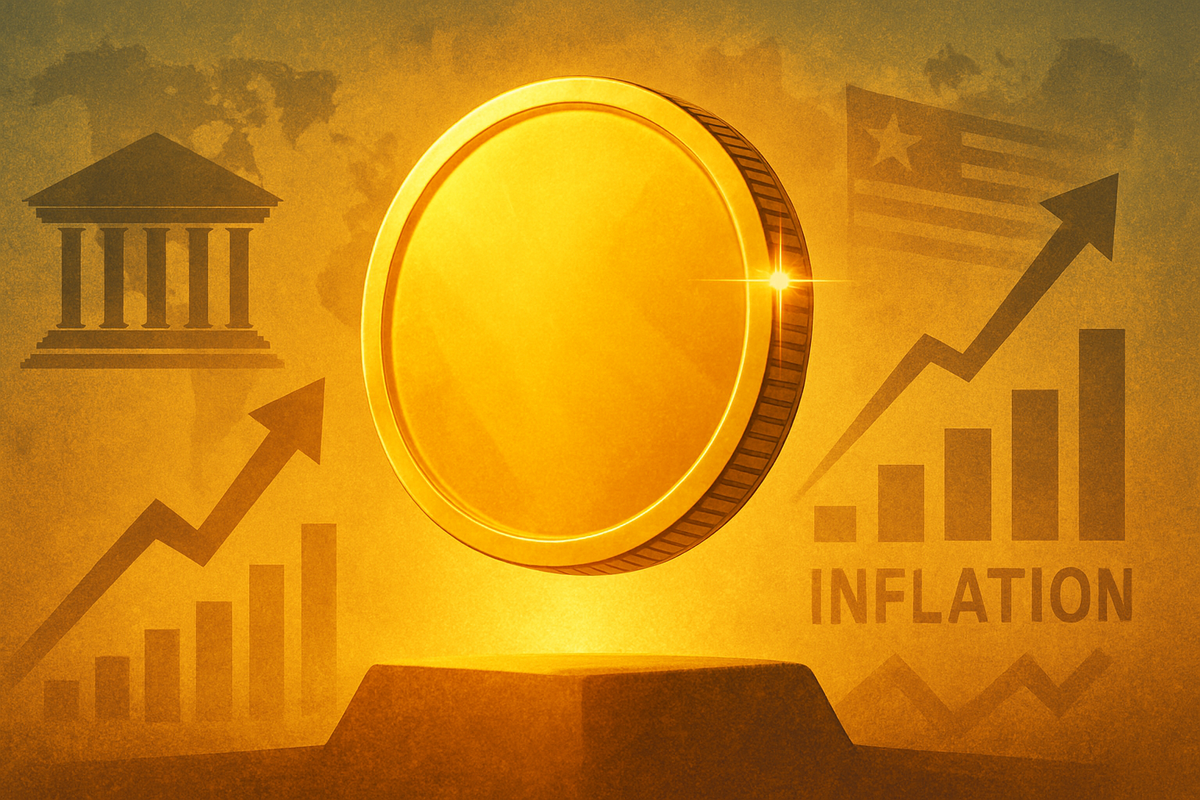
As of October 6, 2025, the global financial markets are witnessing a historic and sustained rally in gold prices, with the precious metal currently trading above $3,900 per ounce and analysts increasingly forecasting a push towards the $4,000 mark. This remarkable surge, characterized by an almost 50% year-to-date gain, reflects a potent cocktail of economic uncertainties, dovish central bank policies, and escalating geopolitical tensions, solidifying gold's perennial role as a safe-haven asset. The implications are far-reaching, signaling a significant shift in investor sentiment and potentially reshaping portfolio strategies worldwide.
The immediate drivers behind this unprecedented momentum are multifaceted. Persistent inflation concerns continue to erode purchasing power, pushing investors towards tangible assets. Simultaneously, a more accommodative stance from the Federal Reserve, with anticipated rate cuts throughout 2025, diminishes the appeal of interest-bearing assets and reduces the opportunity cost of holding non-yielding gold. Furthermore, a weakening US dollar makes gold more attractive to international buyers, while aggressive accumulation by global central banks underscores a strategic de-dollarization trend. Adding to the immediate anxiety is an ongoing US government shutdown, which has further intensified market uncertainty and propelled safe-haven flows into the yellow metal.
Unpacking Gold's Historic Climb: Drivers and Market Reactions
Gold's journey to its current elevated status has been nothing short of spectacular. After a robust 27% increase in 2024, the precious metal has accelerated its ascent in 2025, reaching new all-time highs, including an intraday peak of approximately $3,949.34 and an all-time high of $3,969.52. This sustained upward trajectory marks gold's strongest annual performance since 1979, underscoring a fundamental shift in market dynamics. The rally is not merely speculative; it is deeply rooted in a confluence of structural and cyclical factors.
A primary catalyst has been the unwavering demand for gold as a safe haven. Ongoing geopolitical conflicts, particularly in regions like Russia-Ukraine and the Middle East, coupled with political instability in major economies such as Japan and France, have steered investors towards assets perceived as stable stores of value. Concurrently, the Federal Reserve's anticipated rate-cutting cycle throughout 2025, including probable 25 basis point cuts in October and December, has provided significant tailwinds. Lower interest rates reduce the attractiveness of bonds and other fixed-income instruments, making gold a more compelling alternative. This dovish pivot by the Fed, combined with a softening US dollar, creates an ideal environment for gold's appreciation.
Key players in this rally extend beyond individual investors to include sovereign entities. Central banks globally, notably those in emerging markets and China, have been aggressively expanding their gold reserves. This strategic buying spree is a clear indication of a concerted effort to diversify away from dollar-denominated assets and bolster national financial stability, providing a robust floor for gold prices. Initial market reactions have been overwhelmingly bullish, with a consensus among leading financial institutions pointing towards the $4,000 target. HSBC, Goldman Sachs (NYSE: GS), UBS, Bank of America (NYSE: BAC), and J.P. Morgan (NYSE: JPM) are among those forecasting gold to reach or exceed this level by late 2025 or mid-2026, citing a combination of structural demand, monetary policy, and geopolitical risks. While some analysts note that gold is currently in "extremely overbought" conditions, with potential for minor pullbacks, these dips are largely viewed as buying opportunities within a broader bullish trend.
Corporate Fortunes: Winners and Losers in the Golden Era
A sustained gold rally towards the $4,000 mark creates a clear delineation between beneficiaries and those facing headwinds in the public markets. The most direct and significant winners are undoubtedly gold mining companies and gold-backed Exchange Traded Funds (ETFs).
Gold mining companies stand to see their profitability and stock performance surge. As gold prices rise, their profit margins expand significantly, leading to robust cash flows and earnings. This financial strength allows miners to pivot from cost-cutting to growth strategies, including increased exploration and development budgets, re-evaluating previously marginal projects, and potentially engaging in mergers and acquisitions to consolidate reserves. Major players like Newmont Corporation (NYSE: NEM), the world's largest gold miner, are positioned for exceptional gains, with analysts projecting substantial earnings per share upside. Barrick Gold Corporation (NYSE: GOLD), known for its operational efficiency, and Agnico Eagle Mines Limited (NYSE: AEM) are also poised for enhanced performance. Royalty and streaming companies like Franco-Nevada Corporation (NYSE: FNV) and Wheaton Precious Metals (NYSE: WPM) benefit immensely, as they receive a percentage of production or revenue without incurring direct mining costs, making their business models highly profitable in a rising price environment. Gold-backed ETFs such as iShares Gold Trust Micro (IAUM), Goldman Sachs Physical Gold ETF (AAAU), and SPDR Gold MiniShares Trust (GLDM) directly track gold prices, experiencing significant appreciation and attracting massive capital inflows, which in turn boosts management fees for their providers.
Conversely, companies heavily reliant on gold as a raw material, particularly in the mass-market jewelry sector, could face significant challenges. Increased input costs can lead to margin compression if these companies cannot pass the higher costs to price-sensitive consumers. This may force them to adjust product offerings, shifting towards smaller designs or alternative materials, or focusing on more affluent niche markets. Signet Jewelers Limited (NYSE: SIG) is an example of a company that could face such headwinds, while luxury brands like Tiffany & Co. (part of LVMH) might be more resilient due to their less price-sensitive clientele. Beyond direct gold users, companies in other industries that use gold in small quantities, such as high-tech electronics, might see marginal increases in input costs. More broadly, if the gold rally signifies underlying economic anxieties and persistent inflation, companies in highly competitive or commoditized sectors, or those with significant variable-rate debt, could suffer from rising operational costs or increased interest expenses. Investors holding substantial short positions on gold or gold mining stocks would also incur significant losses.
Wider Significance: A Global Economic Barometer
The sustained gold rally towards $4,000 per ounce is more than just a market event; it is a profound indicator of shifting global economic and geopolitical landscapes. This ascent is deeply intertwined with broader industry trends, signaling a significant re-evaluation of risk and value across international markets.
One of the most compelling trends illuminated by gold's surge is the acceleration of de-dollarization. Central banks, especially in emerging economies like China, India, and Russia, are aggressively accumulating gold reserves. This strategic diversification away from dollar-denominated assets reflects a growing desire to reduce reliance on the U.S. dollar, hedge against potential sanctions, and safeguard national wealth in an increasingly fragmented geopolitical environment. Gold is perceived as a politically neutral, universally accepted, and non-digital alternative to fiat currencies. This trend, coupled with escalating geopolitical tensions in the Middle East and Eastern Europe, reinforces gold's traditional role as a safe-haven asset, driving investors towards its perceived stability amidst global uncertainty.
The ripple effects of a $4,000 gold price extend across various asset classes. While gold mining stocks surge, the rally highlights that investors are hedging against inflationary and political risks that traditional bonds cannot fully address, potentially leading to easing Treasury yields. Other precious metals like silver and platinum have also seen significant rallies, with silver reaching a 14-year high, driven by its dual role as a safe haven and an industrial metal crucial for green technologies. A weakening U.S. dollar, often a precursor and consequence of gold rallies, makes gold more attractive to international buyers and could further amplify dollar weakness against other major currencies, implying a continued depreciation of the U.S. dollar's value. In some regions, like China, where traditional wealth stores such as real estate have faced challenges, retail investors are increasingly turning to physical gold as a safer alternative.
For central banks and governments, a $4,000 gold price presents both challenges and opportunities. The aggressive accumulation by central banks is expected to continue, potentially accelerating the move towards a multi-reserve currency system and impacting global trade. Governments might face increased pressure to manage persistent inflation, and the debate around gold's role in the international monetary system could reignite, potentially leading to discussions about gold-backed currencies. Moreover, increased scrutiny on gold flows and ownership could prompt new regulations related to anti-money laundering and combating the financing of terrorism. Historically, the current environment draws strong parallels to the 1970s and the post-2008 financial crisis era, both characterized by inflation, geopolitical instability, and unprecedented national debt, underscoring gold's enduring role as a reliable hedge against systemic risk and a barometer of global confidence. However, historical patterns also warn of potential volatility and corrections, even within strong bull markets.
The Road Ahead: Navigating Gold's Future Trajectory
As gold solidifies its position near $4,000 per ounce, the market anticipates a dynamic period ahead, shaped by ongoing macroeconomic shifts and geopolitical developments. Both short-term fluctuations and long-term structural trends will define gold's future trajectory.
In the short term (late 2025 - early 2026), gold is expected to experience continued volatility and potential consolidation. While a direct, linear ascent to $4,000 and beyond is unlikely, major financial institutions project gold to cross this psychological barrier in the near term or by mid-2026, driven by sustained central bank purchases, anticipated Federal Reserve rate cuts, and persistent geopolitical risks. Technical indicators suggest that gold may be nearing overbought levels, hinting at potential minor pullbacks or profit-taking periods. However, such dips are generally viewed as buying opportunities within the broader bullish trend, with strong support levels identified around $3,898 and $3,868.
Looking further into the long term (beyond mid-2026), the outlook for gold remains overwhelmingly bullish. Analysts foresee new record highs, with projections ranging from $4,200 to $4,500 by mid-2026, and even the possibility of reaching $5,000 in a "stress scenario" involving a crisis of confidence in the Fed or significant geopolitical escalation. This long-term strength is underpinned by continued central bank and institutional demand for diversification, persistent inflation hedging needs, and gold's resilience as a safe haven amidst ongoing global economic uncertainty. While volatility will remain a feature, the overarching trend is expected to be upward, with wider trading ranges as markets adjust to elevated price levels.
For investors, strategic adaptations are crucial. Portfolio rebalancing, with a moderate allocation to precious metals (typically 5-15%), is recommended for diversification and defensive positioning. Given the elevated prices, a dollar-cost averaging approach can mitigate timing risks, with a focus on buying gold on dips. Diversification within the sector, combining physical gold with quality gold mining equities, can capture different aspects of the precious metals cycle. Close monitoring of US interest rates, central bank purchasing trends, the US dollar's evolution, and geopolitical developments will be paramount. For mining companies, the high gold prices translate into expanded profit margins and robust cash flows, enabling increased exploration and development, potential M&A activity, and more generous shareholder returns through dividends and buybacks. However, they must remain vigilant against operational challenges such as environmental pressures and regulatory complexities.
Market opportunities include the potential for new gold-linked financial products and continued investment in the mining sector, which often offers operational leverage to rising gold prices. Challenges include the inherent volatility of gold markets, the possibility of a stronger US dollar dampening demand, fewer-than-anticipated interest rate reductions, or a de-escalation of major geopolitical conflicts that could reduce safe-haven demand. An intriguing aspect is the current simultaneous rally of gold and equities, defying traditional inverse relationships, a phenomenon that investors must watch closely for its eventual breakdown.
Comprehensive Wrap-up: A Golden Future Amidst Uncertainty
Gold's extraordinary rally, pushing prices towards the $4,000 mark as of October 6, 2025, represents a pivotal moment in financial markets. The key takeaways from this event underscore gold's enduring role as a critical asset in times of uncertainty. Its ascent is driven by a powerful combination of central bank diversification away from the US dollar, persistent inflation concerns, anticipated monetary easing by the Federal Reserve, and a volatile geopolitical landscape. These factors have converged to create a robust demand environment for the yellow metal, making it a cornerstone of defensive investment strategies.
Moving forward, the market is poised for continued strength in gold, albeit with periods of volatility and consolidation. The consensus among leading financial institutions points to the $4,000 target being reached, if not surpassed, in the near to medium term. This sustained high-price environment will usher in a "golden era" for gold mining companies and related investment vehicles, boosting their profitability, cash flows, and growth prospects. Conversely, industries reliant on gold as a raw material, such as certain segments of the jewelry sector, may face margin pressures and strategic adjustments.
The lasting impact of this rally extends beyond mere price appreciation. It signifies a deeper structural shift in global finance, characterized by a move towards a multi-reserve currency system and a heightened awareness of systemic risks. Gold's performance serves as a barometer of global confidence, or lack thereof, in traditional financial instruments and geopolitical stability. Investors should interpret this rally not as a fleeting trend, but as a confirmation of gold's fundamental value as a hedge against inflation and a safe haven during times of turmoil.
What investors should watch for in the coming months includes the Federal Reserve's actual interest rate trajectory, the evolution of the US dollar, continued central bank buying data, and any significant shifts in geopolitical tensions. While the path to $4,000 and beyond may be marked by short-term corrections, the underlying drivers suggest that gold's long-term bullish narrative remains firmly intact. Diversification, strategic entry points, and diligent risk management will be paramount for those looking to navigate this dynamic and potentially lucrative period in the gold market.
This content is intended for informational purposes only and is not financial advice





